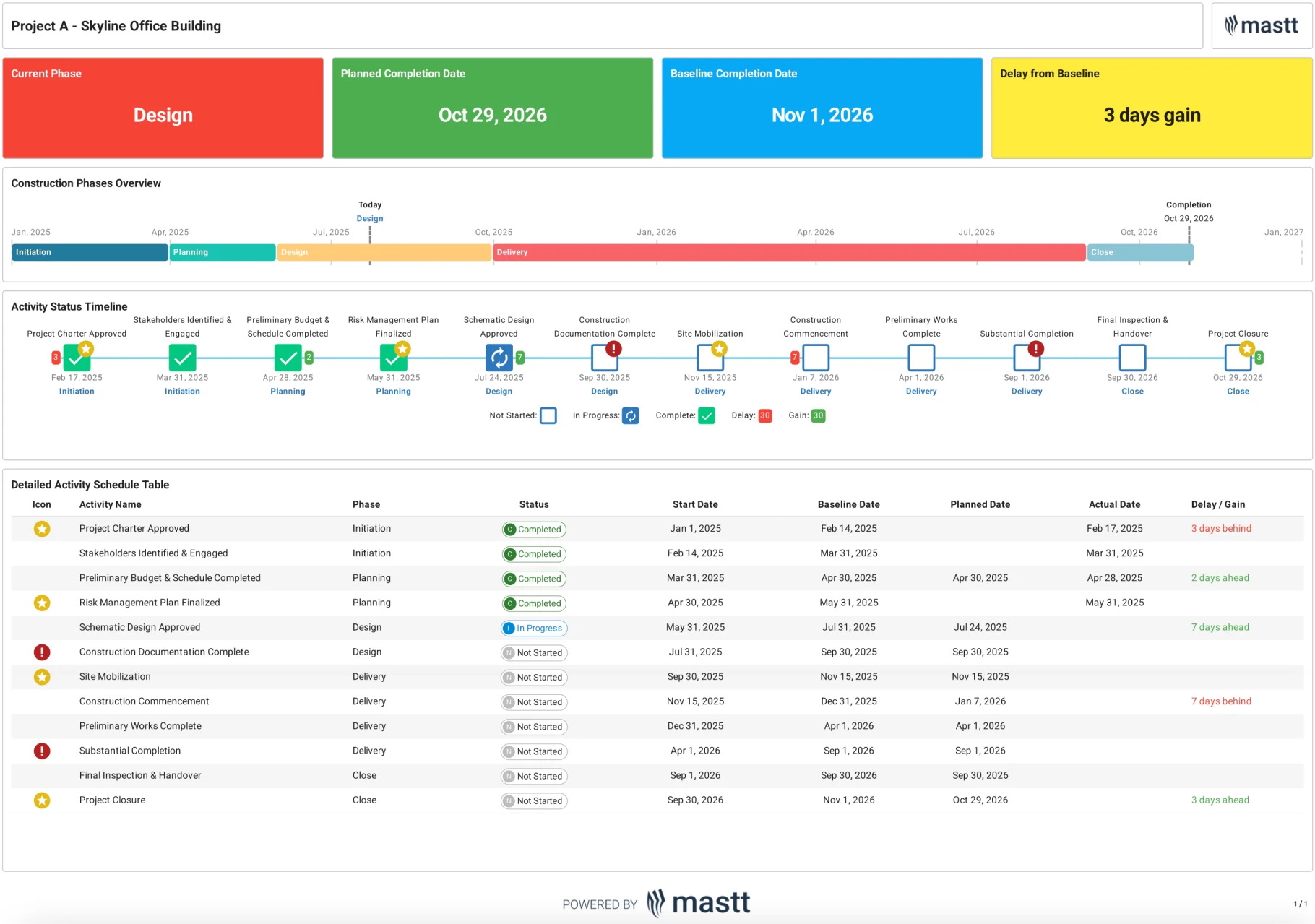Critical Path Analysis (CPA) is an essential technique in construction project management. It focuses on identifying the sequence of tasks that directly influence the project's completion time. By recognizing these critical activities, project managers can allocate resources efficiently, anticipate potential delays, and keep projects on track.
This guide explains what Critical Path Analysis is, its importance in construction projects, and provides practical examples to help you apply CPA in your projects effectively.
What is Critical Path Analysis?
Critical Path Analysis (CPA) is a project management technique that identifies the sequence of activities that are crucial for completing a project on time. The "critical path" consists of tasks that must be completed on schedule because any delay in these tasks will directly impact the entire project’s timeline. The critical path has zero slack or float, meaning there is no room for delay in these activities.
In construction projects, where time-sensitive tasks are interconnected, CPA enables project managers to pinpoint these key activities, prioritize resources, and make informed decisions about scheduling. For instance, if laying a building’s foundation is part of the critical path, any delay in this task will inevitably delay dependent tasks, such as framing and roofing. Recognizing the critical path ensures that these essential tasks are executed with careful attention to avoid disruptions in the timeline.
Why is Critical Path Analysis Important in Construction Projects?
Effective time management is critical in construction projects. Here’s why implementing Critical Path Analysis is key:
- Improves Scheduling and Resource Allocation: Construction projects involve multiple teams and resources. Identifying the critical path allows project managers to allocate the right resources to the most time-sensitive tasks, preventing delays. This approach ensures that the project schedule is realistic and well-structured.
- Enables Proactive Risk Management: Construction projects often face unexpected challenges such as weather delays or supply shortages. CPA helps project managers anticipate which tasks are critical and build contingency plans, minimizing risks to project timelines.
- Facilitates Communication and Decision-Making: CPA creates a transparent timeline that allows stakeholders, contractors, and team members to understand project priorities. This clarity supports effective communication and decision-making throughout the project lifecycle.
- Reduces Delays and Controls Costs: Unanticipated delays are a common cause of budget overruns. By identifying the longest chain of dependent tasks, CPA helps project managers focus on what matters most. When critical tasks are monitored closely, delays and associated costs can be minimized.
How Does Critical Path Analysis Work?
To apply Critical Path Analysis effectively, follow these steps:
- List All Tasks and Activities: Identify all tasks required for project completion. Break them down into smaller, manageable activities to ensure nothing is overlooked.
- Determine Task Dependencies: Establish the relationships between tasks. For example, in a construction project, the foundation must be laid before the walls can be built. Understanding these dependencies is vital for sequencing tasks.
- Estimate the Duration of Each Task: Assign an estimated duration for each task based on historical data or experience. Accurate estimates are crucial for creating a reliable schedule.
- Create a Network Diagram: Use the task dependencies and durations to create a network diagram. This visual representation, often shown as a flowchart, displays each task as a node connected by arrows indicating dependencies.
- Identify the Critical Path: Calculate the earliest and latest possible start and finish times for each task. Tasks with zero slack form the critical path, which represents the sequence of activities that will determine the project’s finish date.
- Monitor and Update the Critical Path Regularly: Construction projects are dynamic, with constant changes. Monitoring the critical path helps keep the project on track. If there are changes or delays, recalculating the critical path is necessary to adjust the schedule.
Example of Critical Path Analysis in Construction
Let’s illustrate with a practical example:
Project: Construction of a Single-Floor Residential House
- Tasks:
- Site preparation (3 days)
- Laying the foundation (7 days)
- Framing the structure (10 days)
- Roofing (5 days)
- Electrical and plumbing (8 days)
- Wall finishing and painting (6 days)
- Dependencies:
- Site preparation must be completed before laying the foundation.
- The foundation must be laid before framing starts.
- Framing must be finished before roofing and electrical/plumbing work begins.
- Electrical and plumbing must be completed before wall finishing and painting.
After analyzing these tasks and their dependencies, the critical path is:
Critical Path: Site Preparation → Foundation → Framing → Roofing → Electrical and Plumbing → Wall Finishing and Painting.
This critical path takes 39 days to complete. If any task on this path is delayed, the entire project timeline will be impacted.
In this scenario, tasks not on the critical path, such as interior detailing, have more flexibility without delaying project completion.
Benefits of Using Critical Path Analysis
- Enhanced Control Over Project Timelines: With a clear understanding of the critical path, project managers gain better control over project timelines and can make informed decisions on resource allocation.
- Improved Team Efficiency: When team members are aware of critical tasks, they can focus on completing those tasks efficiently. This clarity fosters a collaborative environment and ensures accountability.
- Better Risk Management and Preparedness: CPA helps project managers anticipate potential risks and develop mitigation strategies in advance. If unexpected events occur, project managers are better equipped to address them.
Challenges in Critical Path Analysis
While CPA offers numerous advantages, it also presents some challenges:
- Time-Consuming and Complex: In large construction projects, manually identifying and monitoring the critical path can be labor-intensive and prone to errors. Project management software can help automate this process but still requires accurate data input.
- Dependency on Accurate Data: The success of CPA relies heavily on the accuracy of task durations and dependencies. Inaccurate estimates can lead to incorrect critical paths and flawed schedules.
- Dynamic Changes in Projects: Construction projects frequently experience changes in scope, resources, and timelines. These changes require regular updates to the critical path, which can be challenging without robust project management tools.
In Summary
Critical Path Analysis is an invaluable technique in the field of construction project management. It offers a structured approach to identify and monitor key activities that directly impact the project’s timeline, ensuring that stakeholders stay informed and that resources are allocated efficiently. Whether you are managing a small residential construction or a large infrastructure project, mastering CPA will significantly improve your ability to deliver on time and within budget.






.avif)






.avif)


